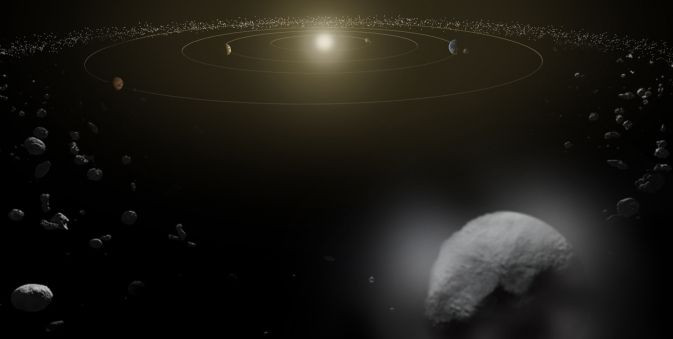Water Vapor Plumes Discovered On Dwarf Planet Ceres, Asteroid-Like Object Has ‘Icy Surface’

Water plumes have been discovered on one of the largest bodies in the asteroid belt, the dwarf planet Ceres.
Astronomers made the discovery while analyzing data from the Herschel Space Observatory satellite and detected evidence of water on the Texas-sized dwarf planet, the Associated Press reports.
"This is the first time water vapor has been unequivocally detected on Ceres or any other object in the asteroid belt and provides proof that Ceres has an icy surface and an atmosphere," Michael Küppers of European Space Agency in Spain and lead author of a paper published in the journal Nature, said in a statement.
The findings were well timed. After a year spent in orbit around the large asteroid Vesta, NASA’s Dawn mission is set to arrive at Ceres in the spring of 2015 and will take a closer look at the plumes.
"We've got a spacecraft on the way to Ceres, so we don't have to wait long before getting more context on this intriguing result, right from the source itself," Carol Raymond, the deputy principal investigator for Dawn at NASA's Jet Propulsion Laboratory in Pasadena, Calif., said. "Dawn will map the geology and chemistry of the surface in high resolution, revealing the processes that drive the outgassing activity."
Ceres was first spotted in 1801. At the time astronomers thought it was a planet orbiting between Mars and Jupiter. Later, other space objects with similar orbits were found which constitute our solar system's main belt of asteroids.
Astronomers have suspected Ceres contained water, but this is the first sign of physical evidence of the plumes’ existence. Ceres is one of the few planets in the solar system to have one of the essential ingredients to sustain life. Ceres joins the likes of Jupiter's moon Europa – believed to have an underground ocean -- and the Saturn moon Enceladus, where jets of water have been observed on the surface.
When NASA’s Dawn arrives, Ceres will be near its farthest point from the sun – not an ideal vantage point to spot the water plumes. But the spacecraft will have instruments able to detect water and map it, Raymond told the AP.
Astronomers believe the water is coming from dark regions on Ceres’ surface, but are not sure of the cause. One theory is that the vapor is the product of the sun’s heat melting ice on the planet’s surface or near-surface that escapes to space.
"Another possibility," Kuppers explained to the BBC, "is that there is still some energy in the interior of Ceres, and this energy would make the water vent out in a similar way as for geysers on Earth, only that with the low pressure at the surface of the asteroid, what comes out would be a vapor and not a liquid."
Once NASA’s Dawn approaches Ceres and takes a closer look, astronomers will be able to tell whether the planet has these spewing geysers, known as cryo-volcanism.
"It's not an atmosphere like Earth's in that most of the water escapes into space due to Ceres's comparably low gravity. In that respect it is more similar to a comet," Küppers told National Geographic. "I do not expect a stable atmosphere."
Since Ceres is an asteroid with comet-like features, the latest discovery may lead to a new understand of asteroids and comets. It also sheds light on how water functions in the solar system.
"The lines are becoming more and more blurred between comets and asteroids," said Seungwon Lee of the Jet Propulsion Labratory. "We knew before about main belt asteroids that show comet-like activity, but this is the first detection of water vapor in an asteroid-like object."
© Copyright IBTimes 2024. All rights reserved.












